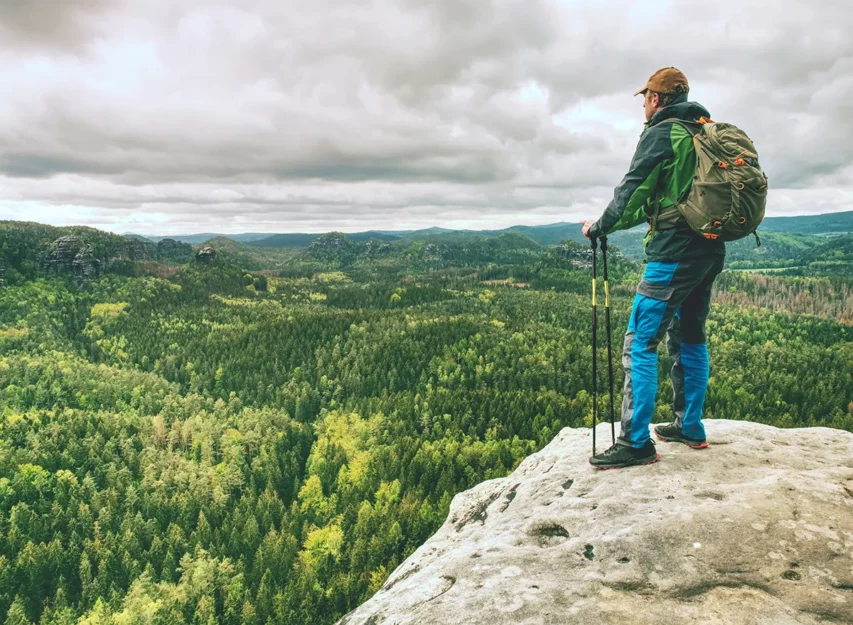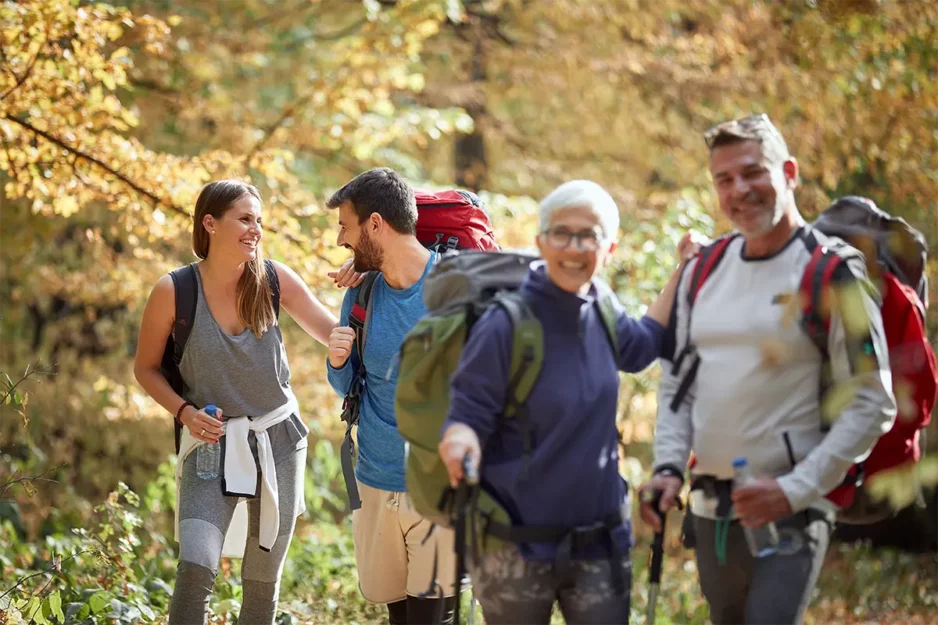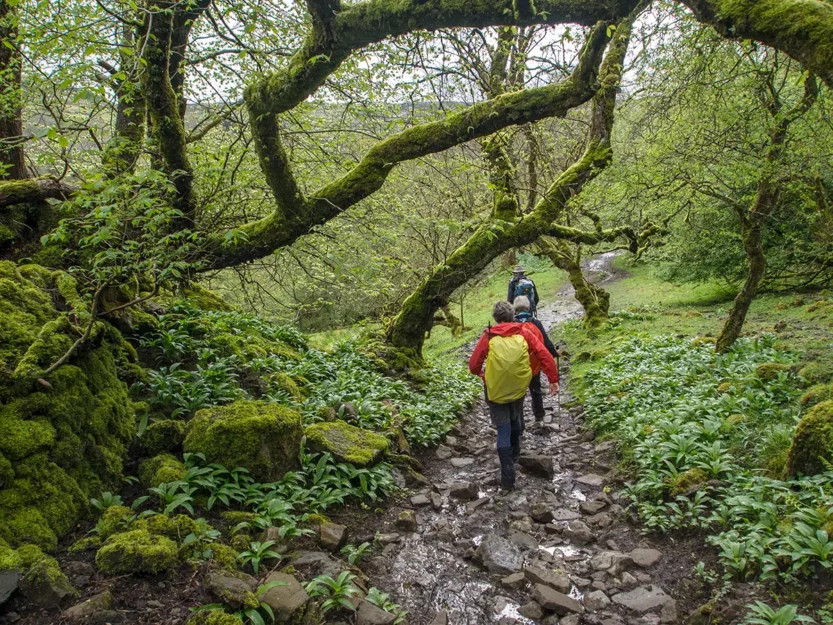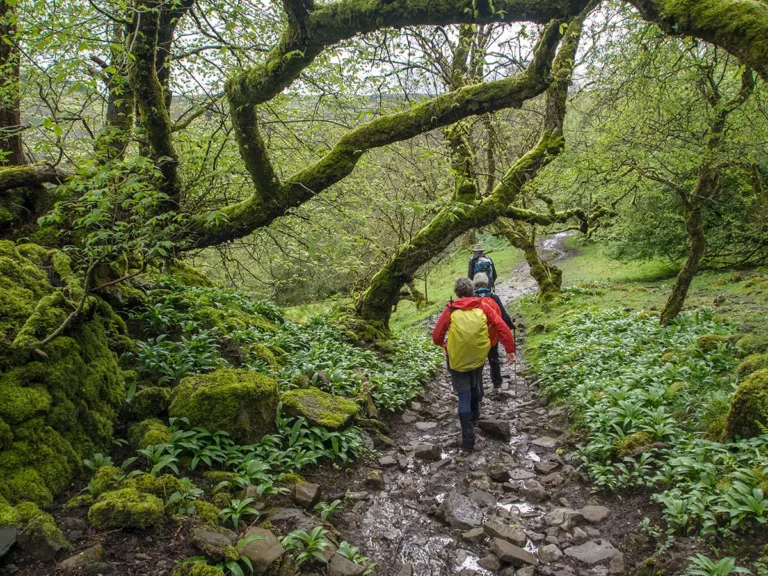Traversing mountaintops and descending valleys while sidestepping boulders and scaling rock faces; that’s what we signed up for as hikers. And our joints and muscles pay the toll with each new terrain and adventure.
Hiking has endless challenges, but your hip pain after hiking is one hazard you never anticipated. You aren’t alone in your pain; acute joint pain is responsible for thirty-six percent of medical complaints after hiking.
Our daily life hips aren’t prepared for rugged hikes. But they will be.
This article helps you identify the cause of your hip pain and provides actions to prevent further hip pain after hiking.
The relationship between hips and hiking
The human body has 360 joints interconnecting muscles and bones. Only four of those joints, the hips and shoulders, feature ball and socket joints.

Hip socket joints are the round head of the femur fitting into the cup of the pelvis. Smooth cartilage lubricates the joints, preventing friction during movement, while the surrounding muscles power the hip to walk, rotate, and squat.
The four primary muscle groups responsible for moving the hip joint are:
- Gluteal: The buttocks muscle allows for hip abduction — movement away from the body at the hip.
- Adductor: Extending from the pubis to the femur, this muscle group allows for adduction, the movement towards the body.
- Iliopsoas: Allows for hip flexion and extends from the pelvis and base of the spine to the femur.
- Lateral rotator: Rotates the femur in the hip joint laterally
Our hips are one of the largest weight-bearing joints in the body, and the stresses of hiking on the hip joint involve all of the surrounding muscles working overtime.
Common causes of hip pain after hiking
Hiking is brutal on the hips.
Compared to smooth surfaces, when walking on uneven surfaces the power placed on the hip joint increases by 75 percent, with around 30 percent more movement. The study by the Journal of Experimental Biology discovered the primary leg muscles were used 60 to 80 percent more when participants walked on a treadmill with raised foam areas.
On a rocky trail, the increased stress easily causes or awakens muscle and joint problems.
The most common cause of hip pain after hiking is muscle strain, but if you’re feeling inner hip pain, it could be a more severe impingement or groin strain.
Hip muscle strain
Your entire supportive muscle group works on hikes. The hips twist, lunge, push, and jump. They take bodyweight impact from one leg while slipping sideways and sliding on loose gravel.
Hip muscles take a beating on the trail, and sore hips after hiking are expected. But when soreness leads to intense pain, it may be caused by a hip muscle strain.
The hip can become overstrained through repeated stress, causing pain, weakness, and limiting the range of motion.
A common strain when hiking is the hip flexor strain. The hip flexors are the muscle group responsible for bringing your knee toward your chest, frequently done stepping up boulders and climbing steep mountains.
Hip flexor pain after hiking will cause sudden pain that increases as you lift your knee towards you. Walking up steps or getting out of a chair will be painful with a hip flexor strain.
Hip muscle strain relief
When experiencing muscle strain, use the RICE method as a first treatment.
- Rest: Immediately stop your activity and continue resting for 48 hours.
- Ice: Apply an ice pack for 15 to 20 minutes every two to three hours.
- Compression: Wrap the strained area to prevent swelling. Avoid overtightening.
- Elevation: Keep the affected area elevated above your heart.
Keep a first aid kit in your backpack with Tylenol or Advil. Pain relievers can help ease your long walk back.
Additional Outer hip pain causes
Supporting muscles, ligaments, and tendons cause most outer hip pain. When a muscle strain isn’t the cause, the pain is often due to the following:
- Hip bursitis: Our bodies contain small fluid-filled sacks called bursae. Bursae sacks act as a buffer between the bones and soft tissue, reducing friction. Bursitis is when the bursae become inflamed from repetitive stress or injury, causing sharp pains.
- Tendonitis: When tendons — the cord of fibers connecting muscles to the bone — are inflamed, it causes gradual hip pain and tenderness. RICE (Rest, Ice, Compression, Elevation), and stretches help to alleviate tendonitis.
Inner hip pain
The outer and inner hips share bursitis, but many additional conditions are limited to inner hip pain, including:
- Groin strain
- Hip flexor strain
- Labral tear
- Osteoarthritis
- Hip impingement syndrome
Hip impingement
Hip impingement is when the head of the femur isn’t rounded, causing an ill-fitting joint in the hip socket. Often developmental and formed during adolescence, hip impingement is either cam, pincer, or a combination of both.
- Cam impingement: The most common cause of hip arthritis, cam impingement is when a bump on the head of the femur causes the bone to not set perfectly in the socket.
- Pincer impingement: A pincer impingement is when the pelvis has an excess amount of bone that extends over the femur, causing the two to pinch the rim of the socket.
How to avoid hip pain after hiking
You would expect to be sore after your first day back to the gym, so hiking shouldn’t be a surprise either. It takes time for the body to adjust to the stresses of the trail.
But over time and repeated use, the joints and muscles around your hips strengthen and loosen. Using exercises and stretching will not only help to expedite your conditioning, but it will prevent long-term injuries.
Hip strengthening exercises for hiking
Your hips are your core. Hips stabilize us and support our upper and lower body movements. Keeping your hip muscles strong helps prevent injuries in the hips, knees, and lower back.
The five hip exercises you can start today at home are:
- Hip hike
- Lunges
- Knee lifts
- Split squat
- Hip abduction
If you have a gym membership, add the adductor and abductor machine to your regular rotation.

Hip stretches to loosen your hips before hiking
Stepping onto the trail with tight, cold muscles and joints is a surefire way to create an injury. By completing simple stretching exercises, you can loosen your hip’s range of motion, preventing inflammation and pain.
Dynamic stretches to complete before hiking are:
- Hip circles
- Heel kicks
- Hamstring kicks
- Butterfly stretch
- Hip flexor and quadriceps stretch
Why am I getting right hip pain after hiking?
When stepping up on a large boulder, do you step with your right leg or left? If you’re right-side dominant, your power leg should be your right. And the most dominant leg typically handles the highest load of stress.
A study published in the Journal of Hip Preservation Surgery showed a direct correlation between the dominant leg and injuries caused to the hip.
Of patients who underwent surgery on their right side, 57% were right-side dominant. In comparison, left-side dominant patients underwent surgery on their left side 61% of the time.
Final thoughts
Pain is your body’s messaging system. Without it, we wouldn’t know to be more cautious or to focus on a weak point of our body. Your hip pain after hiking is a direct order to start stretching and strength training your hips.
When first getting started hiking, work up to more challenging hikes to avoid injury or extreme soreness. Too often, beginner hikers are unprepared for the body tole of hiking rugged terrain with sharp elevation changes.
There’s a world of short, easy hikes that will lead you to some of the most beautiful views of nature.
Between now and your next hike, stretch your hips daily and complete a routine of air squats and lunges, continuing a few days each week. Before hitting the trail, complete your same stretches to ensure your hips are loose.
Taking a long walk in beautiful nature is far more enjoyable when it doesn’t end in pain. Through regular training, you’ll appreciate hiking without suffering the next day.
Did you determine the cause of your hip pain after hiking? Share this article to help others on a similar journey.








